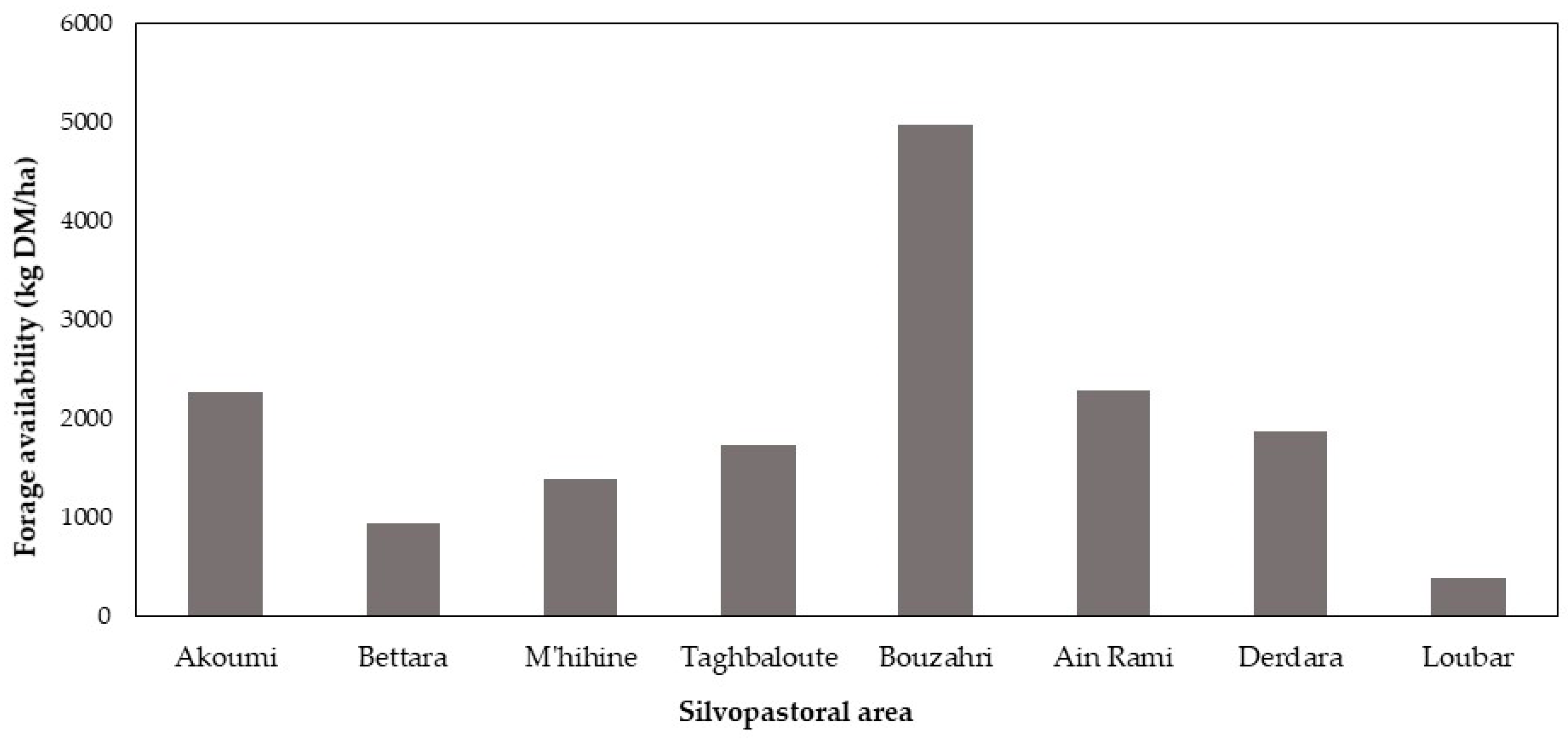Silvopastoral System in Morocco: Focus on Their Importance, Strategic Functions, and Recent Changes in the Mediterranean Side
Abstract
:1. Introduction
2. Methods
3. Results and Discussion
3.1. Moroccan Silvopastoral System
3.1.1. Forest Importance and Evolution
3.1.2. Socio-Economic Conditions
3.1.3. Animal Production and Silvopastoral System
3.1.4. Changes in Social Patterns and Production Systems
- A.
- Dependance of livestock system on pasture
- B.
- Territorial dynamics and transformations
- C.
- Changes in production systems
- Production intensification tendency: High production of milk and meat requires a good quality of varied breeds and an important demand for inputs (feed supplementation);
- Drought: The effects of drought play a crucial role in changing farming practices that usually depend on natural resources (rangelands), such as a trend towards the establishment of fodder reserves (more forage crops), purchasing more animal feed, and a reduction in the number of livestock;
- Herd mobility regression: For several decades, herd mobility, which ensured the sustainability of pastoral resources, has strongly regressed due to a decrease in the herd size of small and medium breeders who were following water points and croplands affected by the recurrent droughts of the past three decades, the clearing of the best rangelands, and the breakdown of the social structures and traditional institutions responsible for the management of pastoral resources;
- Poor availability of water (watering): Rangelands are characterized by an insufficient network of water for livestock watering. This situation is reflected by the reduction in herd performance following movements in search for water and by the poor use of pastoral and silvopastoral areas;
- Weak supervision of breeders: Pastoral and silvopastoral regions are characterized by insufficient supervision of breeders, resulting in poor livestock performance. In addition to that, the lack of strategies that take climate risk into account contributes to the vulnerability of livestock systems.
3.1.5. Climate Change Impacts
3.1.6. Silvopastoral Management Programs
- The German Society for International Cooperation (GIZ) as part of the regional silva-Mediterranea project (adapting the framework for forestry policy to meet the needs of climate change in the Middle East and North Africa (MENA) region) from 2010 to 2014.
- The German bilateral cooperation (BMELV) was also participating (until the end of 2017) in forest conservation and the definition of management methods.
- The French Development Agency (AFD) is involved in environmental protection and adaptation to climate change programs.
- The Food and Agriculture Organization (FAO) intervenes within the framework of a project aiming to reduce poverty and fight desertification.
3.2. Mediterranean Silvopastoral System of Northern Morocco
3.2.1. Silvopastoral System Functions
- A.
- Ecological and environmental functions
- B.
- Socio-economic function
- C.
- Pastoral function
3.2.2. Silvopastoral Area Changes and Its Drivers
3.3. Crucial Sustainable Development Actions
- Generate alternative sources of income for local populations: Developing other economic activities such as ecotourism to reduce pressure on silvopastoral areas;
- Use of available renewable energy technologies, i.e., solar and wind power, to reduce deforestation;
- Silvopastoral rehabilitation of degraded areas: Planting fodder shrubs will contribute to increase short-term and medium-term fodder production and to reduce the impact on rangelands;
- Management of forest defenses (protection): Sustainable management of forests cannot be guaranteed unless defending and regenerating options are considered over a certain period depending on the forest species. The purpose is to save the forest without neglecting the interests of users. The efforts to be undertaken aim to reconcile the short- and medium-term productive and economic benefits of extensive livestock farming systems and the long-term sustainable management of silvopastoral resources;
- The participatory approach can also be applied through the involvement of user breeders in the self-development process and the creation of basic socio-economic infrastructures likely to enhance grazing and forest exploitation practices;
- A tax for forest grazing must be implemented. It should be proportional to the herd size and farmer’s financial situation. The collected taxes should be reinvested in silvopastoral rehabilitation.
4. Conclusions
Author Contributions
Funding
Institutional Review Board Statement
Informed Consent Statement
Data Availability Statement
Acknowledgments
Conflicts of Interest
References
- Gomes, F.J.; Pedreira, B.C.; Santos, P.M.; Bosi, C.; Lulu, J.; Pedreira, C.G.S. Microclimate effects on canopy characteristics of shaded palisadegrass pastures in a silvopastoral system in the Amazon biome of central Brazil. Eur. J. Agron. 2020, 115, 126029. [Google Scholar] [CrossRef]
- Papanastasis, V.P. Silvopastoral systems and range management in the Mediterranean region. In Western European Silvopastoral Systems; Etienne, M., Ed.; FAO: Rome, Italy, 1996; pp. 143–156. [Google Scholar]
- San Miguel, A. Gestión silvopastoral y conservación de especies y espacios protegidos. In Pastos, Desarrollo y Conservación; Robles, A.B., Ramos, M.E., Morales, M.C., Simón, E., González-Rebollar, J.L., Boza, J., Eds.; Junta de Andalusia: Granada, Spain, 2003; pp. 409–422. [Google Scholar]
- Robles, A.B. The Mediterranean pastures and silvopastoral systems: Basic concepts. In Agroforestry Systems as a Technique for Sustainable Land Management; Mosquera-Losada, M.R., Fernández-Lorenzo, J.L., Rigueiro-Rodríguez, A., Eds.; Unicopia Ediciones; AECID: Madrid, Spain, 2009; pp. 59–69. [Google Scholar]
- Casals, P.; Baiges, T.; Bota, G.; Chocarro, C.; de Bello, F.; Fanlo, R.; Sebastia, M.T.; Taull, M. Silvopastoral systems in the Northeastern Iberian Peninsula: A multifunctional perspective. In Agroforestry in Europe: Current Status and Future Prospects; Rigueiro-Rodrı’guez, A., McAdam, J., Mosquera-Losado, M., Eds.; Springer Science and Business Media B.V.: Dordrecht, The Netherlands, 2009; pp. 161–182. [Google Scholar]
- Linares, A.M. Forest planning and traditional knowledge in collective woodlands of Spain: The dehesa system. For. Ecol. Manag. 2007, 249, 71–79. [Google Scholar] [CrossRef]
- Moher, D.; Liberati, A.; Tetzlaff, J.; Altman, D.G. Preferred Reporting Items for Systematic Reviews and Meta-Analyses: The PRISMA Statement. PLoS Med. 2009, 6, e1000097. [Google Scholar] [CrossRef] [PubMed] [Green Version]
- Kimmins, J.P. Ecosystem management and landscape ecology: The ultimate focus in forest ecology. In Forest Ecology. A Foundation for Sustainable Forest Management and Environmental Ethics in Forestry, 3rd ed.; Chapter 19; Prentice Hall: Upper Saddle River, NJ, USA, 2003. [Google Scholar]
- FAO (Food and Agriculture Organization of the United Nations). Base des Données Statistiques de la FAO (FAOSTAT). 2011. Available online: http://www.fao.org/faostat/fr/#data (accessed on 20 April 2021).
- PAPFM (Programme Additionnel au Programme D’appui à la Politique Forestière au Maroc). ANNEXE I de la Décision D’exécution de la Commission Relative au Programme D’action Annuel—Partie 2. 2017. Available online: https://www.gtai.de/resource/blob/40862/537dbabfc9d88bfadadf55e75b475f4e/pro201711175004-data.pdf/ (accessed on 20 April 2021).
- Baguare, A. Evaluation de L’approche Participative en Matière de Gestion Forestière. Cas de la Commune Rurale Oued Ifrane; Rapport de Recherche; ONDH: Rabat, Morocco, 2013; 112p. [Google Scholar]
- Faouzi, H. The Agdal in the dynamics of farming fystems of the Haha (western High Atlas, Morocco). Etudes Caribéennes 2011, 20, 5569. [Google Scholar] [CrossRef]
- Hammi, S.; Simonneaux, V.; Alifriqui, M.; Auclair, L.; Montes, N. Evolution of forest and land coverage from 1964 to 2002 in the high valley of Ait Bouguemez (Central High Atlas, Morocco). Impact of management modes. Sécheresse 2007, 18, 271–277. [Google Scholar]
- Auclair, L.; AlIfriqui, M. Les agdals du Haut Atlas marocain. Enjeux d’une recherche pluridisciplinaire. Cah. Rech. Cent. Jacques Berque 2005, 3, 61–79. [Google Scholar]
- Poupon, J. L’aménagement et l’amélioration des parcours forestiers au Maroc 2ème Partie. Forêt Méditerranéenne 1980, 1, 53–60. [Google Scholar]
- Pérez León, N.; Bruzzone, O.; Easdale, M.H. A framework to tackling the synchrony between social and ecological phases of the annual cyclic movement of transhumant pastoralism. Sustainability 2020, 12, 3462. [Google Scholar] [CrossRef] [Green Version]
- Venema, B.; Mguild, A. The vitality of local political institutions in the middle atlas, Morocco. Ethnology 2002, 41, 103–117. [Google Scholar] [CrossRef]
- MAPM (Ministère de l’Agriculture, de la Pêche Maritime). Deuxième Rapport National sur L’état des Ressources Génétiques Animales Royaume du Maroc; MAPM: Rabat, Morocco, 2014. [Google Scholar]
- Pattanayak, S.K.; Mercer, D.E.; Sills, E.; Yang, J.C. Taking stock of agroforestry adoption studies. Agrofor. Syst. 2003, 57, 173–186. [Google Scholar] [CrossRef]
- Montagnini, F. Management for sustainability and restoration of degraded pastures in the Neotropics. In Post-Agricultural Succession in the Neotropics; Myster, R., Ed.; Springer: New York, NY, USA, 2008; pp. 265–295. [Google Scholar]
- Calle, A.; Montagnini, F.; Zuluaga, A.F. Farmer’s perceptions of silvopastoral system promotion in Quindío, Colombia. Bois Forêts Trop. 2009, 300, 79–94. [Google Scholar] [CrossRef]
- Naggar, M. Stratégie sylvopastorale et renouveau des pratiques pastorales en forêt au Maroc. Rev. For. Française 2018, 70, 487–501. [Google Scholar] [CrossRef] [Green Version]
- Naggar, M. Eléments de base d’une stratégie de sylvopastoralisme en Afrique du Nord. Options Méditerranéennes 2000, 39, 191–202. [Google Scholar]
- Naggar, M. Le parcours en forêt et l’aléa climatique—Un enjeu d’écologie social? In Proceedings of the XII World Forestry Congress, Québec City, QC, Canada, 21–28 September 2003. [Google Scholar]
- Naggar, M. La question pastorale et les enjeux de la gouvernance territoriale de l’arganeraie. Espace Géograph. Société Maroc. 2019, 30, 5–12. [Google Scholar]
- Chebli, Y.; El Otmani, S.; Chentouf, M.; Hornick, J.-L.; Cabaraux, J.-F. Temporal variations in chemical composition, in vitro digestibility, and metabolizable energy of plant species browsed by goats in southern Mediterranean forest rangeland. Animals 2021, 11, 1441. [Google Scholar] [CrossRef] [PubMed]
- Chentouf, M.; Arrebola Molina, F.; Boulanouar, B.; Mesbahi, H.; Terradillos, A.; Caravaca, F.; Casas, C.; Bister, J.L. Caractérisation des systèmes de production caprine semi-extensifs en Andalousie et au Nord du Maroc: Analyse comparative. Options Méditerranéennes 2009, 91, 37–42. [Google Scholar]
- Chentouf, M.; Boulanouar, B.; Bister, J.L. Elevage caprin au Nord du Maroc; INRA-Editions Press: Rabat, Morocco, 2015; 168p. [Google Scholar]
- Mahdi, M. Pasteur de l’Atlas: Production pastorale, droit et rituel, Casablanca. Fondation Konrad Adenauer. Études Rural. 1999, 159–160. [Google Scholar] [CrossRef]
- Chebli, Y.; Chentouf, M.; Ozer, P.; Hornick, J.L.; Cabaraux, J.F. Forest and silvopastoral cover changes and its drivers in northern Morocco. Appl. Geogr. 2018, 101, 23–35. [Google Scholar] [CrossRef]
- Chebli, Y.; Chentouf, M.; Hornick, J.L.; Cabaraux, J.F. Extensive goat production systems in northern Morocco: Production and use of pastoral resources. In Grassland Resources for Extensive Farming Systems in Marginal Lands: Major Drivers and Future Scenarios; Porqueddu, A., Franca, C., Lombardi, A., Molle, G., Peratoner, G., Hopkins, G., Eds.; Wageningen Academic Publishers Press: Wageningen, The Netherlands, 2017; pp. 131–133. [Google Scholar]
- Gillet, F.; Peringer, A. Dynamic modelling of silvopastoral landscape structure: Scenarios for future climate and land use. In Managing Resources of a Limited Planet, Proceeding of the International Congress on Environmental Modelling and Software, 6th Biennial Meeting, Leipzig, Germany, 1–5 July 2012; Seppelt, R., Voinov, A.A., Lange, S., Bankamp, D., Eds.; International Environmental Modelling and Software Society: Manno, Switzerland, 2012. [Google Scholar]
- Peringer, A.; Siehoff, S.; Chételat, J.; Spiegelberger, T.; Buttler, F. Gillet. Past and future landscape dynamics in pasture-woodlands of the Swiss Jura Mountains under climate change. Ecol. Soc. 2013, 18, 11. [Google Scholar] [CrossRef] [Green Version]
- Moukrim, S.; Lahssini, S.; Rhazi, M.; Mharzi Alaoui, H.; Benabou, A.; Wahby, I.; El Madihi, M.; Arahou, M.; Rhazi, L. Climate change impacts on potential distribution of multipurpose agro-forestry species: Argania spinosa (L.) Skeels as case study. Agroforest. Syst. 2019, 93, 1209–1219. [Google Scholar] [CrossRef]
- Elame, F.; Doukkali, R.; Lionboui, H. Dynamic modeling of climate change impact on agricultural lands and water resources. In Handbook of Climate Change Management; Leal Filho, W., Luetz, J., Ayal, D., Eds.; Springer: Cham, Switzerland, 2020; pp. 1–21. [Google Scholar] [CrossRef]
- Ait Brahim, Y.; Seif-Ennasr, M.; Malki, M.; N’da, B.; Choukrallah, R.; El Morjani, Z.E.A.; Sifeddine, A.; Abahous, H.; Bouchaou, L. Assessment of climate and land use changes: Impacts on groundwater resources in the Souss-Massa River Basin. In The Souss-Massa River Basin, Morocco. The Handbook of Environmental Chemistry; Springer: Cham, Switzerland, 2016; Volume 53, pp. 121–142. [Google Scholar] [CrossRef]
- Tramblay, Y.; Ruelland, D.; Somot, S.; Bouaicha, R.; Servat, E. High-resolution Med-CORDEX regional climate model simulations for hydrological impact studies: A first evaluation of the ALADIN-Climate model in Morocco. Hydrol. Earth Syst. Sci. 2013, 17, 3721–3739. [Google Scholar] [CrossRef] [Green Version]
- FAO (Food and Agriculture Organization of the United Nations). Rapport National du Maroc. Forêts, Parcours et Changement Climatique Dans la Région du Proche Orient, le Caire. 20–22 September 2011. Available online: http://www.fao.org/forestry/29290-019a95bbd8583bf54d5b1f62639881cf0.pdf (accessed on 20 April 2021).
- Elame, F.; Doukkali, R.; Fadlaoui, A. Modélisation économique de l’impact des changements climatiques sur les ressources en eau. Newmedi 2016, 15, 10–18. [Google Scholar]
- Ilmen, R.; Benjelloun, H. Les écosystèmes forestiers marocains à l’épreuve des changements climatiques. Forêt Méditerranéenne 2013, 3, 195–208. [Google Scholar]
- M’hirit, O.; Benzyane, M.; Benchekroun, F.; El Yousfi, S.M.; Bendaanoun, M. L’arganier, une Espèce Fruitière-Forestière à Usages Multiples; Mardaga: Sprimont, Belgique, 1998; 145p. [Google Scholar]
- Zeino-Mahmalat, E.M.; Bennis, A. Environnement et changement climatique au Maroc—Diagnostic et Perspectives, 1st ed.; Konrad-Adenauer-Stiftung: Rabat, Morocco, 2012; 90p. [Google Scholar]
- MAPMDREF (Ministère de L’Agriculture, de la Pêche Maritime, du Développement Rural et des Eaux et Forêts). Forêts en Chiffre. Département des Eaux et Forêts. 2018. Available online: http://www.eauxetforets.gov.ma/ForetsMarocaines/ForetsChiffres/Pages/Forets-En-Chiffres.aspx (accessed on 20 April 2021).
- Mediani, M.; Brito, J.C.; Fahd, S. Atlas of the amphibians and reptiles of Northern Morocco: Updated distribution and patterns of habitat selection. Basic Appl. Herpetol. 2015, 29, 81–107. [Google Scholar] [CrossRef]
- Grovel, R. La préservation des forêts du Rif centro-occidental: Un enjeu de développement de la montagne rifaine. Rev. Géograph. Alp. 1996, 4, 75–94. [Google Scholar] [CrossRef]
- Quezel, P.; Barbero, M.; Loisel, R. Les reboisements en région méditerranéenne. Incidences biologiques et économiques. Forêt Méditerranéenne 1990, 2, 103–114. [Google Scholar]
- Taiqui, L. La dégradation écologique au Rif marocain: Nécessités d’une nouvelle approche. Mediterranea 1997, 16, 5–17. [Google Scholar] [CrossRef] [Green Version]
- Benabid, A. Ecologie, Conservation et Restauration des Subéraies; Formation Continue à l’ENFI: Salé, Morocco, 1989. [Google Scholar]
- Albergel, J.; Collinet, J.; Zante, P.; Hamrouni, H. Role of the Mediterranean forest in soil and water conservation. In Water for Forests and People in the Mediterranean Region: What Science Can Tell Us? Birot, Y., Garcia, C., Palahi, M., Eds.; European Forest Institute: Joensuu, Finland, 2011; pp. 46–56. [Google Scholar]
- SPEF (Service Provincial des Eaux et Forêts). Potentialité et problématique forestière dans la province de Chefchaouen. In Rapport du Haut-Commissariat aux Eaux et Forêts et à la Lutte Contre la Désertification; SPEF: Chefchaouen, Morocco, 2006. [Google Scholar]
- Sabir, M.; Barthes, B.; Roose, E. Recherche d‘indicateurs de risques de ruissellement et d‘érosion sur les principaux sols des montagnes méditerranéennes du Rif occidental (Maroc). Sci. Chang. Planétaires Sécheresse 2004, 15, 105–110. [Google Scholar]
- Matteucci, G.; Vanclay, J.; Martin-Vide, J. Do forest areas influence rainfall regime? In Water for Forests and People in the Mediterranean Region: A Challenging Balance; Birot, Y., Garcia, C., Palahi, M., Eds.; European Forest Institute: Joensuu, Finland, 2011; pp. 32–36. [Google Scholar]
- Dupouey, J.L.; Pignard, G.; Hamza, N. La séquestration de carbone en forêt. Forêt-Entrep. 2006, 168, 15–18. [Google Scholar]
- FAO (Organisation des Nations Unies pour l’alimentation et l’agriculture). Situation des Forêts du Monde; FAO: Italy, Rome, 2011; 176p. [Google Scholar]
- Qarro, M.; Berkat, O.; M’Hamedi, M.; Yessef, M. L’aménagement sylvopastoral: Contraintes et développement durable. In Rupture: Nouveaux Enjeux, Nouvelles Fonctions, Nouvelle Image de L’élevage sur Parcours; Bourbouze, A., Qarro, M., Eds.; CIHEAM-IAMM: Montpellier, France, 2000; pp. 171–174. [Google Scholar]
- HCEFLCD (Haut-Commissariat Eaux et Forêts et Lutte Contre la Désertification). Forêts en Chiffres. 2007. Available online: http://www.eauxetforets.gov.ma/fr/text.aspx?id=1035uid=53 (accessed on 20 April 2021).
- AEFCS (Administration des Eaux et Forêts et Conservation des sols). Actes du Colloque National sur la Forêt, du 21 au 23 Mars à Ifrane; AEFCS: Rabat, Maroc, 2012. [Google Scholar]
- Hammoudi, A. Subéraie et Biodiversité du Paysage; Rapport Présenté à Vivexpo; Institut Méditerranéen du Liège: Vivès, France, 2002; 5p. [Google Scholar]
- Chebli, Y.; El Otmani, S.; Chentouf, M.; Hornick, J.-L.; Bindelle, J.; Cabaraux, J.-F. Foraging behavior of goats browsing in southern Mediterranean forest rangeland. Animals 2020, 10, 196. [Google Scholar] [CrossRef] [Green Version]
- Chebli, Y.; Chentouf, M.; Mrabet, R.; Keli, A. Production et utilisation des parcours dans les montagnes rifaines du nord du Maroc. Options Méditerranéennes 2014, 108, 109–113. [Google Scholar]
- DRATT (Direction Régionale de l’Agriculture de Tanger-Tétouan). Monographie de la Région du nord du Maroc. Rapports et Données Statistiques sur L’agriculture et L’élevage. 2017. Available online: http://www.dratt.ma/ (accessed on 20 April 2021).
- Chentouf, M.; Zantar, S.; Doukkali, M.R.; Farahat, L.B.; Jouamaa, A.; Aden, H. Performances techniques et économiques des élevages caprins dans le nord du Maroc. Options Méditerranéennes 2011, 100, 151–156. [Google Scholar]
- Chebli, Y.; Mrabet, R. Les ressources pastorales dans le domaine rifain. In L’élevage caprin au nord du Maroc; Chentouf, M., Boulanouar, B., Bister, J.L., Eds.; INRA-Editions Press: Rabat, Morocco, 2014; pp. 64–79. [Google Scholar]
- Aubert, P.M. Les évolutions de la politique forestière au Maroc: Entre réappropriation du modèle forestier français et idéalisation de la tribu. Rev. For. Française 2013, 4, 305–316. [Google Scholar] [CrossRef] [Green Version]
- Benabid, A. Le Rif et le Moyen Atlas (Maroc): Biodiversité, menaces, préservation. In Proceedings of the Mountains High Summit Conference for Africa, Nairobi, Kenya, 6–10 May 2002. [Google Scholar]
- Labrousse, A.; Romero, L. Rapport sur la situation du cannabis dans le Rif marocain Observatoire Français des Drogues et des Toxicomanies (OFDT) et Centre d’Etude Rurale et d’Agriculture Internationale (CERAI). 2001. 23p. Available online: https://www.ofdt.fr/BDD/publications/docs/epbxalhc.pdf (accessed on 20 April 2021).
- Mharzi Alaoui, H.M.; Assali, F.; Rouchdi, M.; Lahssini, S.; Tahiri, D. Analyse de l’interaction entre l’éclosion des feux de forêts et les types de bioclimat au Nord du Maroc—Cas de la région du Rif occidental. Rev. Maroc. Sci. Agron. Vét. 2015, 3, 46–53. [Google Scholar]
- Raissouni, A.; Issa, L.K.; Arrim, A.; El Maâtouk, M.; Passalacqua, R. GIS-based model to assess erosion sensitivity in northern Morocco. Laou watershed case study. J. Geosci. 2012, 3, 610–626. [Google Scholar] [CrossRef] [Green Version]
- Sadiki, A.; Bouhlassa, S.; Auajjar, J.; Faleh, A.; Macaire, J.J. Utilisation d’un SIG pour l’évaluation et la cartographie des risques d’érosion par l’équation universelle des pertes en sol dans le Rif oriental (Maroc): Cas du bassin versant de l’oued Boussouab. Bull. L’institut Sci. 2004, 26, 69–79. [Google Scholar]
- HCP (Haut-Commissariat au Plan). Monographie Régionale de Tanger-Tétouan. 2014. Available online: https://www.hcp.ma/region-tanger/attachment/823725/ (accessed on 20 April 2021).
- Afsahi, K.; Darwich, S. Hashish in Morocco and Lebanon: A comparative study. Int. J. Drug Policy. 2016, 31, 190–198. [Google Scholar] [CrossRef] [PubMed]
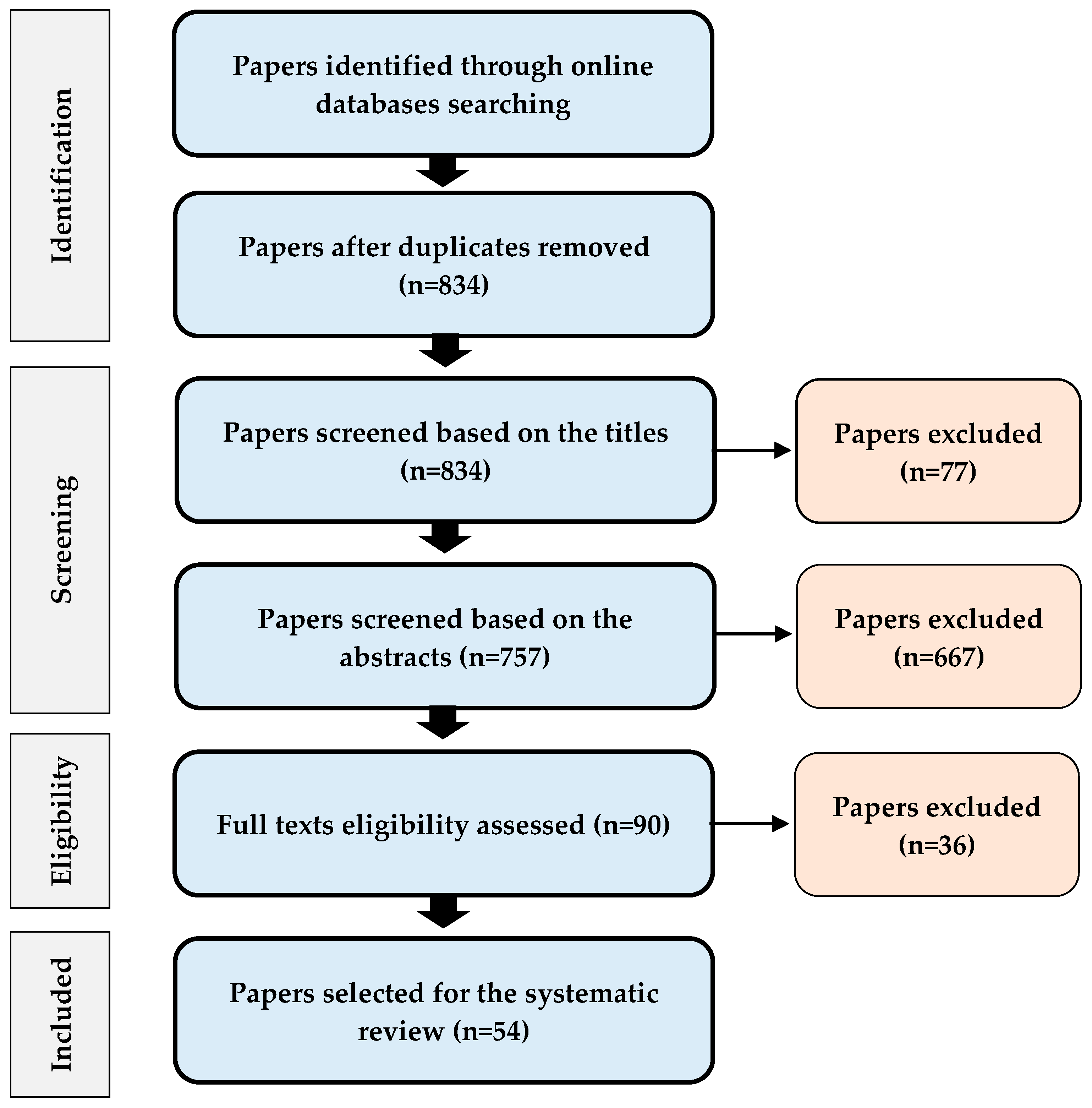
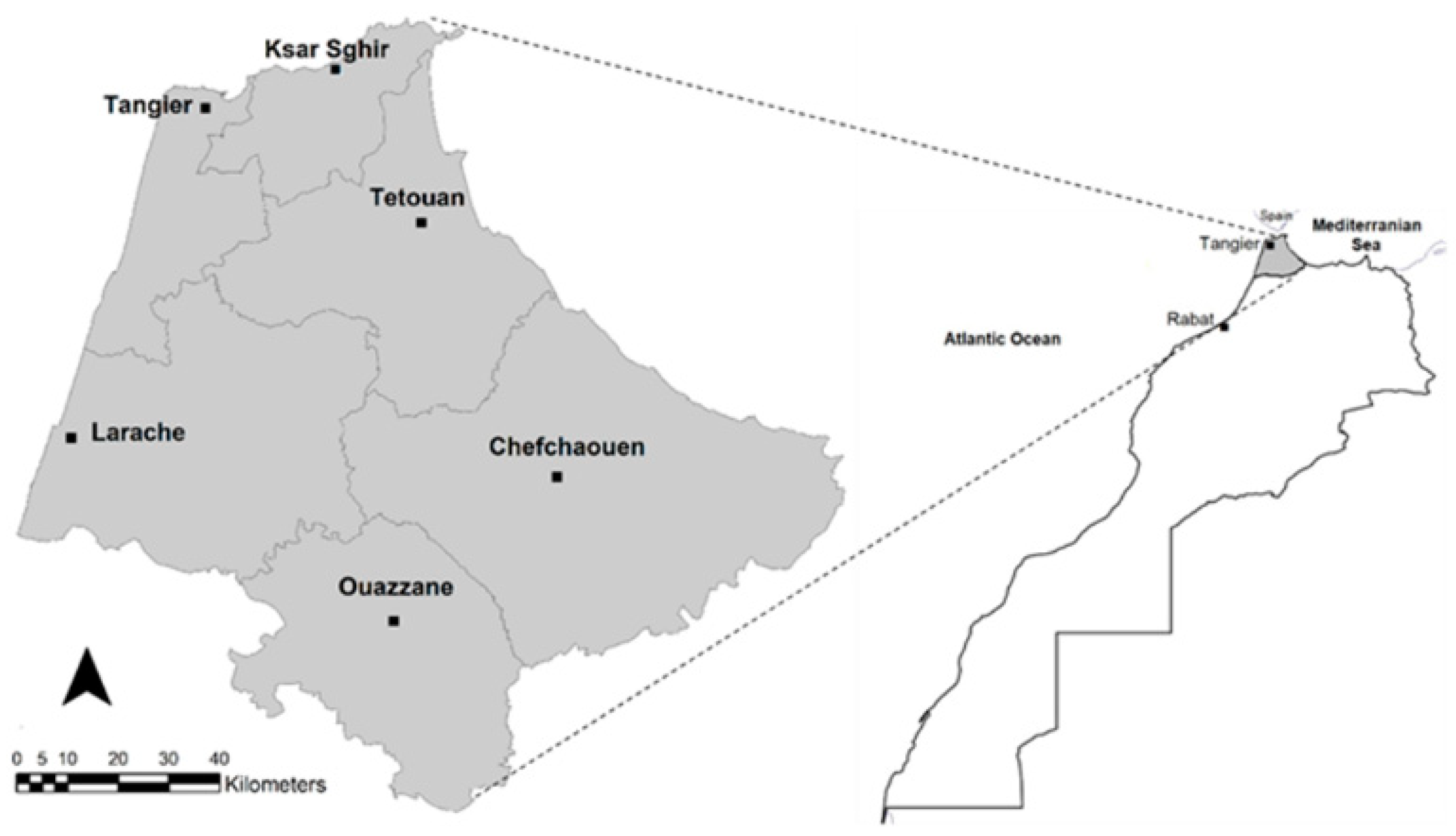
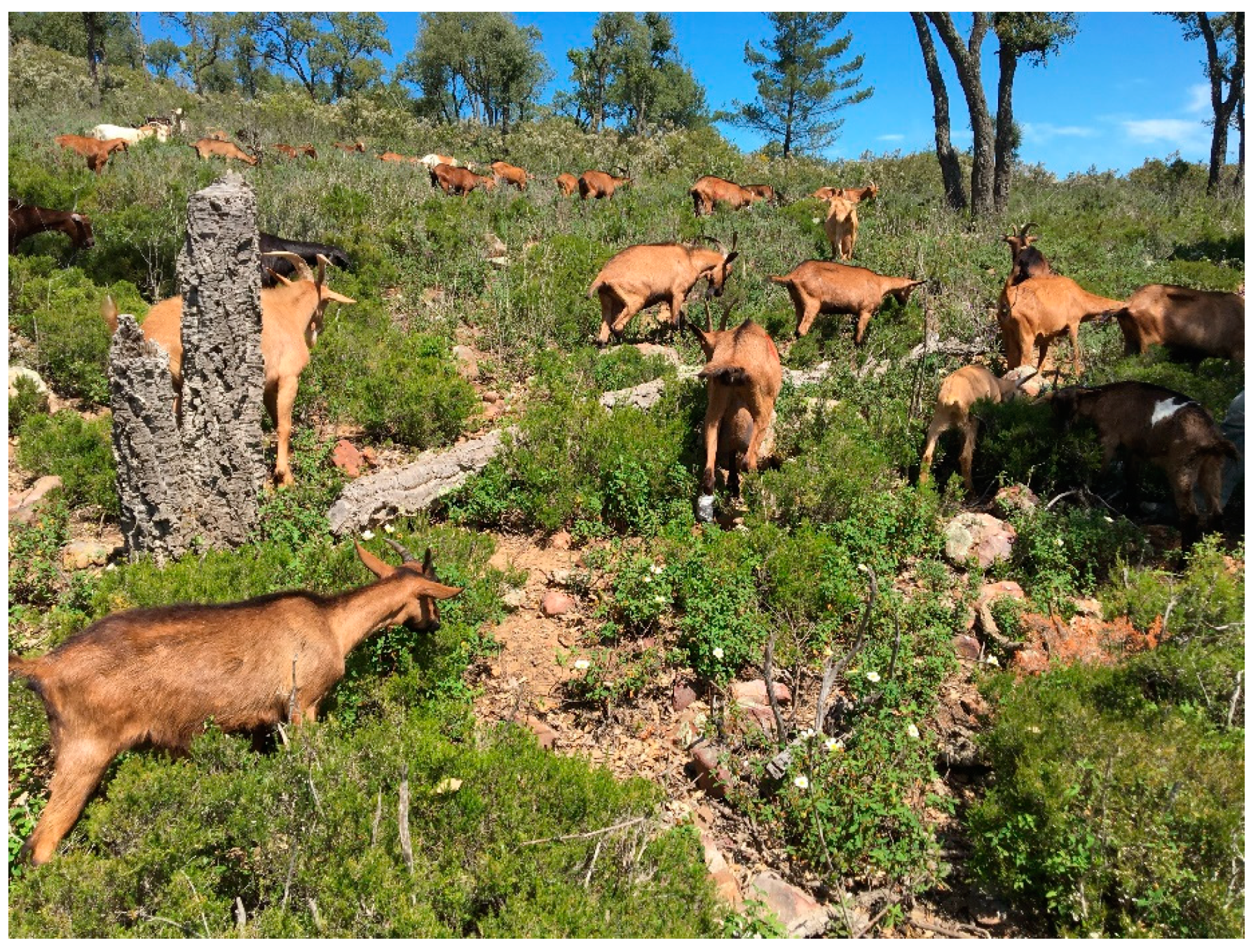
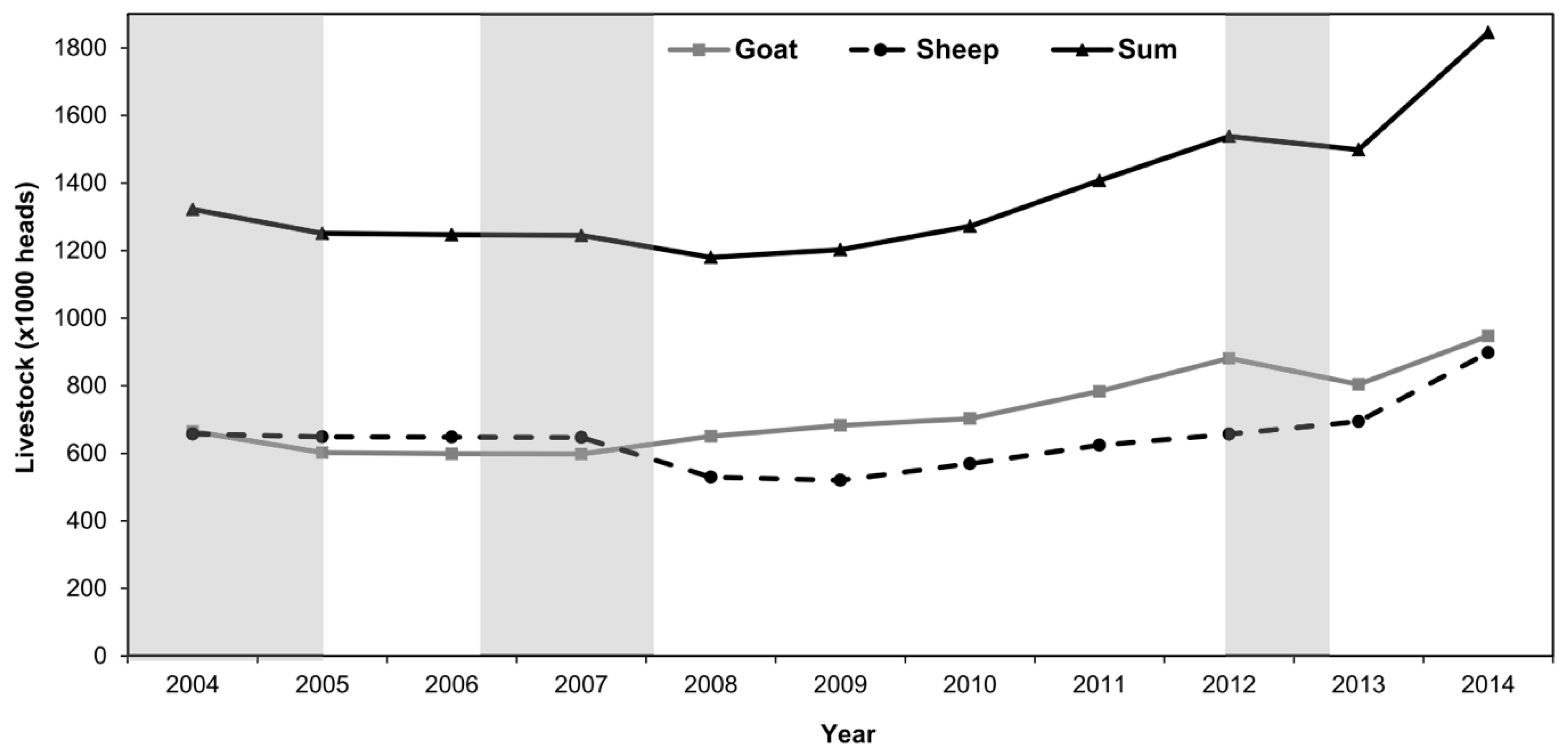
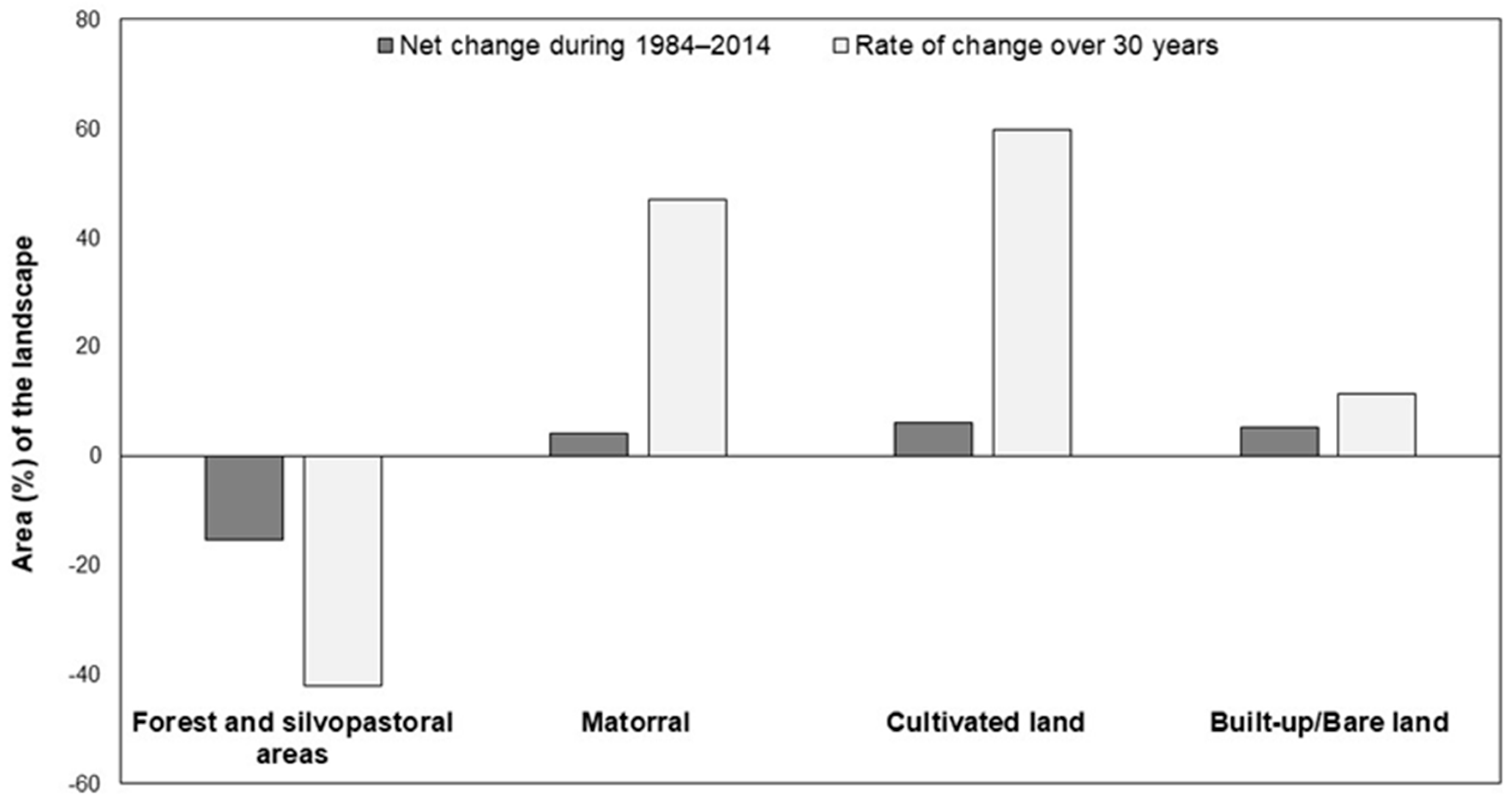
Publisher’s Note: MDPI stays neutral with regard to jurisdictional claims in published maps and institutional affiliations. |
© 2021 by the authors. Licensee MDPI, Basel, Switzerland. This article is an open access article distributed under the terms and conditions of the Creative Commons Attribution (CC BY) license (https://creativecommons.org/licenses/by/4.0/).
Share and Cite
Chebli, Y.; El Otmani, S.; Elame, F.; Moula, N.; Chentouf, M.; Hornick, J.-L.; Cabaraux, J.-F. Silvopastoral System in Morocco: Focus on Their Importance, Strategic Functions, and Recent Changes in the Mediterranean Side. Sustainability 2021, 13, 10744. https://doi.org/10.3390/su131910744
Chebli Y, El Otmani S, Elame F, Moula N, Chentouf M, Hornick J-L, Cabaraux J-F. Silvopastoral System in Morocco: Focus on Their Importance, Strategic Functions, and Recent Changes in the Mediterranean Side. Sustainability. 2021; 13(19):10744. https://doi.org/10.3390/su131910744
Chicago/Turabian StyleChebli, Youssef, Samira El Otmani, Fouad Elame, Nassim Moula, Mouad Chentouf, Jean-Luc Hornick, and Jean-François Cabaraux. 2021. "Silvopastoral System in Morocco: Focus on Their Importance, Strategic Functions, and Recent Changes in the Mediterranean Side" Sustainability 13, no. 19: 10744. https://doi.org/10.3390/su131910744
APA StyleChebli, Y., El Otmani, S., Elame, F., Moula, N., Chentouf, M., Hornick, J.-L., & Cabaraux, J.-F. (2021). Silvopastoral System in Morocco: Focus on Their Importance, Strategic Functions, and Recent Changes in the Mediterranean Side. Sustainability, 13(19), 10744. https://doi.org/10.3390/su131910744






